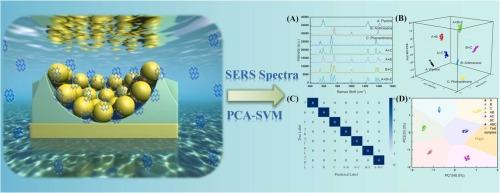结合机器学习算法的光子-等离子体SERS传感器痕量识别与检测多环芳烃
IF 11.3
1区 环境科学与生态学
Q1 ENGINEERING, ENVIRONMENTAL
引用次数: 0
摘要
多环芳烃(PAHs)构成了严重的环境威胁,但由于电磁场增强不足以及底物与分析物的亲和力较弱,通过表面增强拉曼光谱(SERS)检测其痕量水平仍然具有挑战性。本文引入了一个集成了机器学习算法的混合光子-等离子体SERS平台,以解决这些关键限制,提高检测精度和分析效率。由Au膜-聚离子液体(PIL)纳米碗-Au纳米球组成的工程结构,通过光子纳米腔和等离子体热点的协同耦合,共同产生高强度电磁场区域,表现出卓越的检测性能。同时,PIL纳米碗结构通过疏水相互作用和π-π堆叠实现了高效的多环芳烃富集。该集成系统实现了芘、蒽、菲和苯并[a]芘的超灵敏定量,检出限(LOD)为6.1-8.5×10-10 mol/L。值得注意的是,主成分分析(PCA)导出的欧几里得距离与二元混合物的摩尔比之间建立了很强的线性关系(R2=0.998)。此外,通过利用主成分分析和支持向量机(SVM)算法,该传感平台对真实河水基质中7种结构类似的多环芳烃(包括单组分分析物和二元/三元混合物)具有鲁棒性判别能力。本研究提出了一种数据驱动的智能传感策略,集成了纳米材料工程和机器学习算法,从而能够快速、低成本地检测微量有机污染物,特别是那些具有相似化学结构的污染物。本文章由计算机程序翻译,如有差异,请以英文原文为准。

Trace-Level Discrimination and Detection of Polycyclic Aromatic Hydrocarbons via hybrid Photonic-Plasmonic SERS Sensors Integrated with Machine Learning Algorithms
Polycyclic aromatic hydrocarbons (PAHs) pose severe environmental threats, yet their trace-level detection via surface-enhanced Raman spectroscopy (SERS) remains challenging, primarily due to insufficient electromagnetic field enhancement and weak substrate-analyte affinity. Herein, a hybrid photonic-plasmonic SERS platform integrated with machine learning algorithms was introduced to address these critical limitations and enhance detection accuracy as well as analysis efficiency. The engineered architecture, comprising Au film-poly(ionic liquid) (PIL) nanobowl-Au nanosphere, exhibited exceptional detection performance through the synergistic coupling of photonic nanocavities and plasmonic hotspots, which collectively generated high-intensity electromagnetic field regions. Concurrently, the PIL nanobowl structures enabled efficient PAH enrichment via hydrophobic interactions and π-π stacking. This integrated system achieved ultra-sensitive quantification of pyrene, anthracene, phenanthrene, and benzo[a]pyrene, with a limit of detection (LOD) ranging from 6.1–8.5×10-10 mol/L. Notably, a strong linear relationship (R2=0.998) was established between principal component analysis (PCA)-derived Euclidean distances and molar ratios in binary mixtures. Furthermore, by leveraging PCA and support vector machine (SVM) algorithms, the sensing platform demonstrated robust discriminative capability for seven structurally analogous PAHs—including single-component analytes and binary/ternary mixtures—in real river water matrices. This study presents a data-driven intelligent sensing strategy integrating nanomaterial engineering and machine learning algorithms, thereby enabling rapid, low-cost detection of trace organic contaminants, especially those with similar chemical structures.
求助全文
通过发布文献求助,成功后即可免费获取论文全文。
去求助
来源期刊

Journal of Hazardous Materials
工程技术-工程:环境
CiteScore
25.40
自引率
5.90%
发文量
3059
审稿时长
58 days
期刊介绍:
The Journal of Hazardous Materials serves as a global platform for promoting cutting-edge research in the field of Environmental Science and Engineering. Our publication features a wide range of articles, including full-length research papers, review articles, and perspectives, with the aim of enhancing our understanding of the dangers and risks associated with various materials concerning public health and the environment. It is important to note that the term "environmental contaminants" refers specifically to substances that pose hazardous effects through contamination, while excluding those that do not have such impacts on the environment or human health. Moreover, we emphasize the distinction between wastes and hazardous materials in order to provide further clarity on the scope of the journal. We have a keen interest in exploring specific compounds and microbial agents that have adverse effects on the environment.
 求助内容:
求助内容: 应助结果提醒方式:
应助结果提醒方式:


